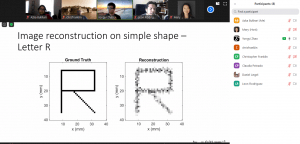DeepMind
We started the week with a big bang! Daniel Angel organized a meeting with Arun Ahuja,. Mr. Ahuja works at DeepMind, which is UK artificial intelligence company founded in September 2010, and acquired by Google in 2014. We learned that their mission is to solve intelligence and use ‘it’ to solve everything else. Mr. Ahuja, I am paraphrasing here, describes intelligence as the ability to use prior experience and acquired knowledge to solve a new problem at hand- that isn’t ‘learned’. In the first two weeks of the SWITCH program, we read a lot about different types of machine learning, DeepMind focuses on one specific type: Reinforcement Learning, which in layman’s term can be described as ‘trial and error’.
The company uses various games as challenges to see if the system is able to solve these games as a learning experience. No prior information is input, the system plays the game, for example, brick breaker and realizes that certain actions will lead to the score increasing, while others will not. It uses this experience of trial and error to refine and complete actions that will lead to an increase in score and therefore the system wins the game. Mr. Ahuja mentioned that AlphaGo (computer program designed by Deep Mind Technologies) was able to beat the best human player at an ancient Chinese game called Go. Another cool fact- the app recommendations on Google App Store were developed by Deep Mind as well.
Diversity in a Classroom
Monday afternoon, we were able to discuss issues that would usually be hard to discuss in a formal setting, especially classroom. That being said, it is vital that we have these necessary but uncomfortable conversations about diversity and implicit bias. Dr. Antoine-Morse informed us about implicit bias and its presence in various social settings, as well as a classroom-setting example from Allen Antoine. Not only did we identify bias, but we got to discuss how we had all seen it in our very own lives, with some hard hitting scenarios from my fellow RETs. Dr. Antoine- Morse dove into identity as well, and its seven aspects: religion, age, race, gender, nationality, ethnicity and class. At the end of it, we discussed that it opened our eyes to our own biases in our classroom as Mr. Franklin stated. However, Mr. Medrano felt that we just dipped our toes in the pool of a very intricate topic and we need more time to discuss and think about diversity in the classroom- I’m inclined to agree with that notion.
Guess who’s back? Back again? Yong is back!
Yongyi Zhao, my last summer mentor, returned to tell us about his mind-blowing project called Magnetic, Optical and Acoustical Neural Access (MOANA)- basically it is non-invasive neuro-imaging. His research project had moved to phase two, where as last year he didn’t have results, he had collected some data. I was excited to see this! MOANA on the deep end would like to bring telepathy to the real world.
Mr. Zhao is concentrating on the “read” aspect of this research project, therefore he is interested in developing a non-invasive, wearable, functional neuroimaging device. I’ll try and explain it in the best terms I can because it was quite a difficult concept for me to wrap my head around. Imaging is a mapping of photons from scene to sensor, however, there is a lot of scattering of this light before it is received by the sensor-due to the presence of skull. Hence, it is difficult to see a clear image- this is where the DOT (Diffuse optical tomography) comes in. It models how light behaves in scattering media, and reverses this process to determine properties of the brain. Mr. Zhao noted that most scattered happened earlier in the received signal- as the photons were unable to reach their final destination, but rather just bounced from other surfaces and returned quicker than anticipated. The dismissal of these earlier signals leads to better signal-to-background ratio.
Above is an image that was shown in the presentation. The first picture of the clear R is the ground truth, and the second is the reconstruction- it isn’t very clear, but you can recognize the general shape of the R. The future applications of this research project are endless- perhaps we aren’t very far away from having telepathy after all.
It isn’t very clear in this picture- but Daniel Angel’s mind was blown by this whole presentation. It was definitely eye opening to say the least.








2 Responses to Mind blown!